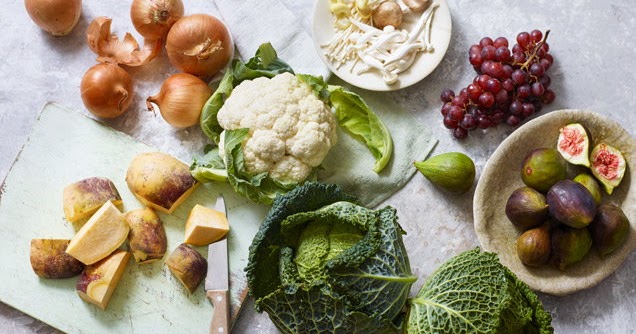Some Foods In Season During September

What's in season in September
As summer turns into autumn, September marks the beginning of heartier seasonal fruit and veg. Cauliflower and swede can be added to salads on warmer days and casseroles as the weather cools. Earthy wild mushrooms and dark Savoy cabbage make delicious vegetarian cooking simple, whilst sticky figs and deep red grapes can be baked into pretty puddings.
Like its cousin broccoli, cauliflower is made up of a close network of small edible flower heads which grow from a thick central stalk. White cauliflower is the most common variety – the creamy round head should be even in colour and surrounded by tight green leaves. While it’s pretty special, please note that if you suffer from irritable bowel syndrome, inflammatory bowel disease, Crohn’s disease, or ulcerative colitis, cauliflower may cause bloating and discomfort, read more here
Some recipes you may like to try:
Cauliflower Cheese and Cauliflower rice - more details here
Cauliflower rice with garlic and chilli prawns - more details here
Cauliflower, six low carb recipe choices - more details here The wide range of mushroom varieties can be categorised into two distinct types; cultivated and wild. There’s plenty to experiment with in the kitchen – roughly 15,000 different varieties of wild mushroom alone can be found in the UK. Although they grow all year round, autumn is the peak of their season. To prepare, brush well to remove any dirt, wipe with a damp cloth and store in a paper bag in the fridge.
Some recipes you may like to try:
Lemon Garlic Pork Steaks with Mushrooms, low carb and gluten free - more details here
Lemon Garlic Pork Steaks with Mushrooms, low carb and gluten free - more details here
Greek Style Roasted Mushrooms with Red Pepper, Herbs and Feta, low carb dish - more details here
Mushroom Bourguignon with Celeriac Mash, Vegetarian - more details hereThis root veg is a turnip-cabbage hybrid and has a sweet, earthy flavour. Americans know it as "rutabaga". The Scottish call it "neeps" and serve it with haggis. I know it as swede, and it is a regular in our house especially as it's low in carbs! This root vegetable, is thought to have originated around the 17th century in Bohemia. In 1620 a Swiss botanist described the root vegetable, believed to be a hybrid of the cabbage and the turnip. By 1664 it was growing in England. It's a good source of vitamin C, fibre, folate and potassium.
Some recipes you may like to try:
Swede / Rutabaga, health and nutrition benefits, and seven recipe choices - more details here
Swede / Rutabaga, health and nutrition benefits, and seven recipe choices - more details here
Panhaggerty, it's a one-pot wonder, lower carb if you use swede - more details here
Fisherman’s Pie, topped with buttery mashed swede - more details here
Fragrant figs have a rich jammy taste and a soft, chewy texture that works in sweet or savoury recipes. Turkish figs are distinctive in appearance, with a dusky purple-brown skin, and vibrant red flesh inside. Figs don’t ripen after picking, so select plump fruits with unbroken skins.
Roasted figs (or tomato) with Parma ham and goat's cheese - more details here
Red grapesSweet red grapes are grown in fertile regions across the Mediterranean and beyond and can be used for more than just lunchbox snacks. Try threading the grapes onto skewers and then dipping in melted dark chocolate for an easy dessert. Juicy grapes complement salty flavours – they are a great match for creamy Brie.
Waldorf Salad Recipe, using red grapes - more details here
Red Grape and brie flatbreads, note this is not a low carb recipe - more details here
A household staple, versatile onions are the first ingredient in a whole host of dishes. Choose onions that feel firm, with papery skins and store in a cool, dry place. To avoid watery eyes when chopping onions, freeze for 10 mins beforehand and avoid cutting through the root. As well as providing the base for sauces and stews, onions can shine on their own. You can get to know your onions, including some health benefits, by reading this post here
Some recipes you may like to try:
Coq Au Vin, low carb recipe, which uses onions (and other vegetables) - more details here
Cheese and Onion Pork Chops - more details here
Caramelised onion, cheese and hazelnut salad - more details here
Savoy cabbage
This dark green, crinkly cabbage has a sweet, earthy flavour and is great eaten cooked or raw. Savoy has slightly looser leaves than other cabbage varieties, but its head should still be compact and weighty, with crisp leaves. This dark green brassica has a distinctive, sweet and slightly earthy taste that stands up well against rich, bold or meaty flavours.
Some recipes you may like to try:
Pork and Apple Meatballs, served with savoy cabbage and a lower carb mash - more details here
Pork and Apple Meatballs, served with savoy cabbage and a lower carb mash - more details here
Braised Savoy cabbage with bacon - more details here
Hungarian Style Savoury Minced Beef, with savoy cabbage and carrots - more details here
I wonder what would be your favourite from the above?
I wonder what would be your favourite from the above?
Mine would be swede, closely followed by cauliflower ...
Dear reader, you will find a variety of articles, studies etc. plus recent news/views and recipe ideas within this blog, we hope something for everyone to read and enjoy ... but please note, not all may be suitable for you. If you may have any food allergies, or underlying health issues these must always be taken into account. If you are a diabetic and not sure how certain foods may affect your blood sugars, test is best, i.e. use your meter.
All the best Jan

Comments
Post a Comment